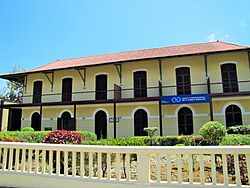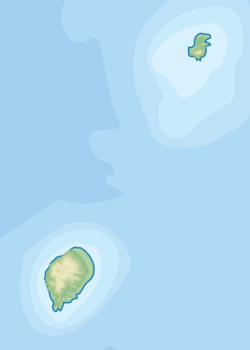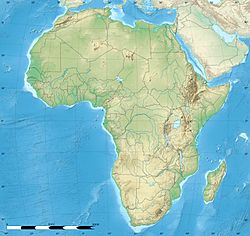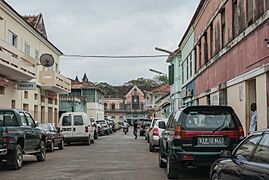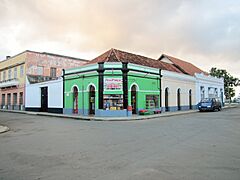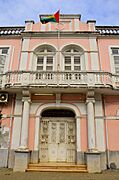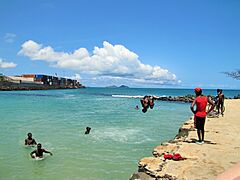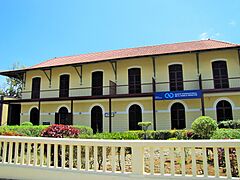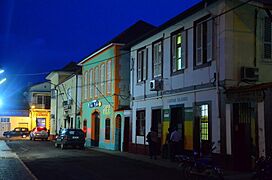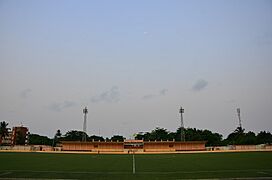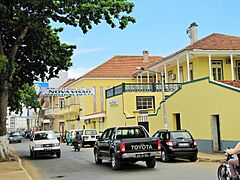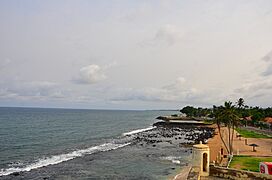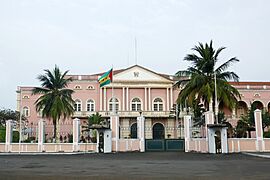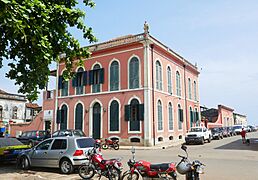São Tomé facts for kids
Quick facts for kids
São Tomé
|
||
|---|---|---|
|
City
|
||
|
(from top: left to right) Downtown São Tomé, Port of Sao Tome, Ana Chaves Bay and Bank International of Sao Tome.
|
||
|
||
| Country | ||
| Island | São Tomé | |
| District | Água Grande | |
| Founded | 1485 | |
| Named for | Thomas the Apostle | |
| Area | ||
| • Total | 17 km2 (7 sq mi) | |
| Elevation | 137 m (449 ft) | |
| Population
(2015 estimate)
|
||
| • Total | 71,868 | |
| • Density | 4,230/km2 (10,900/sq mi) | |
| Time zone | UTC+0 (GMT) | |
| Area code(s) | +239-11x-xxxx through 14x-xxxx | |
São Tomé is the capital and biggest city of São Tomé and Príncipe, an island country in Central Africa. Its name means "Saint Thomas" in Portuguese. It was started in the 15th century, making it one of Africa's oldest cities built by European settlers.
Contents
History of São Tomé
The city of São Tomé was founded in 1493 by Álvaro Caminha. The Portuguese came to the island looking for land to grow sugarcane. Before they arrived around 1470, no one lived on the island.
São Tomé is about 40 kilometers (25 miles) north of the equator. This location gave it a wet climate, perfect for growing sugarcane. In 1497, about 2,000 Jewish children were brought from the Iberian Peninsula. They were eight years old or younger and were brought to be educated in the Catholic faith. Later, people from the nearby African Kingdom of Kongo were brought to the island to work.
São Tomé was a major center for sugar production in the 1500s. However, by 1600, Brazil took over as the main sugar producer.
Key Buildings and Events
The city of São Tomé is built around a cathedral from the 1500s. This cathedral was mostly rebuilt in the 1800s. Another old building is Fort São Sebastião, built in 1566. Today, it is the São Tomé National Museum.
On July 9, 1595, a revolt led by Rei Amador took control of the capital. They were stopped in 1596. In 1599, the Dutch took over the city and the islands for two days. They came back and occupied it again in 1641 for a year.
São Tomé was the capital of the Portuguese colony of São Tomé and Príncipe. When São Tomé and Príncipe became independent in 1975, São Tomé remained the capital of the new country.
Geography and Features
São Tomé is an important port city. It is located on Ana Chaves Bay, in the northeast part of São Tomé Island. A small island called Ilhéu das Cabras is nearby, just offshore.
The city is northeast of Trindade, southeast of Guadalupe, and northwest of Santana. A highway that goes around São Tomé Island connects the city to these towns. There is also a weekly ferry that connects São Tomé to Cape Verde.
City Landmarks and Services
Some important places in São Tomé include the Presidential Palace, the cathedral, and a cinema. The city also has many schools, including middle schools and high schools, and one polytechnic school.
You can find two markets, three radio stations, and the public television station TVSP. There are also several clinics and hospitals. The country's main airport, São Tomé International Airport, is in São Tomé. It has regular flights to Angola, Gabon, Ghana, and Portugal. Sometimes, there are also flights to Príncipe.
São Tomé is the main hub for the island's roads and bus routes. The city is also known for its traditional tchiloli performances.
Population Growth
| Historical population | ||
|---|---|---|
| Year | Pop. | ±% |
| 1990 (June 23, Census) |
42,331 | — |
| 2000 (June 16, Census) |
49,957 | +18.0% |
| 2003 (Estimate) |
53,300 | +6.7% |
| 2018 (July 1, Estimate) |
71,868 | +34.8% |
Transportation in São Tomé
São Tomé is served by São Tomé International Airport. This airport offers regular flights to countries in Europe and other parts of Africa.
Climate and Weather
São Tomé has a tropical wet and dry climate (Köppen As). It's close to a semi-arid climate (BSh) because of the cold Benguela Current. This current makes even the wettest months drier than you might expect for a place so close to the equator. However, it also makes the city very cloudy and foggy, even during the dry season in the middle of the year.
The city has a long wet season from October to May and a short dry season. São Tomé gets just under 900 millimeters (35 inches) of rain each year on average. Temperatures in the city stay fairly steady. Average high temperatures are usually around 30°C (86°F), and average low temperatures are around 22°C (72°F).
| Climate data for São Tomé (São Tomé International Airport) | |||||||||||||
|---|---|---|---|---|---|---|---|---|---|---|---|---|---|
| Month | Jan | Feb | Mar | Apr | May | Jun | Jul | Aug | Sep | Oct | Nov | Dec | Year |
| Record high °C (°F) | 32.0 (89.6) |
33.6 (92.5) |
33.5 (92.3) |
33.4 (92.1) |
33.9 (93.0) |
31.0 (87.8) |
30.7 (87.3) |
31.0 (87.8) |
31.7 (89.1) |
31.5 (88.7) |
31.6 (88.9) |
32.0 (89.6) |
33.9 (93.0) |
| Mean daily maximum °C (°F) | 29.4 (84.9) |
29.9 (85.8) |
30.2 (86.4) |
30.1 (86.2) |
29.3 (84.7) |
28.0 (82.4) |
27.3 (81.1) |
27.7 (81.9) |
28.6 (83.5) |
28.7 (83.7) |
29.0 (84.2) |
29.1 (84.4) |
28.9 (84.0) |
| Daily mean °C (°F) | 25.9 (78.6) |
26.2 (79.2) |
26.4 (79.5) |
26.4 (79.5) |
26.0 (78.8) |
24.7 (76.5) |
23.8 (74.8) |
24.1 (75.4) |
25.0 (77.0) |
25.2 (77.4) |
25.5 (77.9) |
25.6 (78.1) |
25.4 (77.7) |
| Mean daily minimum °C (°F) | 22.4 (72.3) |
22.5 (72.5) |
22.6 (72.7) |
22.6 (72.7) |
22.6 (72.7) |
21.4 (70.5) |
20.4 (68.7) |
20.5 (68.9) |
21.3 (70.3) |
21.8 (71.2) |
22.0 (71.6) |
22.1 (71.8) |
21.8 (71.2) |
| Record low °C (°F) | 19.1 (66.4) |
19.6 (67.3) |
19.2 (66.6) |
19.4 (66.9) |
18.5 (65.3) |
14.0 (57.2) |
14.0 (57.2) |
13.4 (56.1) |
16.0 (60.8) |
18.3 (64.9) |
18.8 (65.8) |
19.6 (67.3) |
13.4 (56.1) |
| Average rainfall mm (inches) | 81 (3.2) |
84 (3.3) |
131 (5.2) |
122 (4.8) |
113 (4.4) |
19 (0.7) |
0 (0) |
1 (0.0) |
17 (0.7) |
110 (4.3) |
99 (3.9) |
108 (4.3) |
885 (34.8) |
| Average rainy days (≥ 0.1 mm) | 8 | 8 | 12 | 11 | 10 | 3 | 2 | 3 | 6 | 12 | 11 | 8 | 94 |
| Average relative humidity (%) | 85 | 84 | 83 | 83 | 84 | 79 | 77 | 78 | 79 | 82 | 85 | 85 | 82 |
| Mean monthly sunshine hours | 142.6 | 135.6 | 139.5 | 126.0 | 145.7 | 165.0 | 161.2 | 148.8 | 120.0 | 114.7 | 135.0 | 142.6 | 1,676.7 |
| Mean daily sunshine hours | 4.6 | 4.8 | 4.5 | 4.2 | 4.7 | 5.5 | 5.2 | 4.8 | 4.0 | 3.7 | 4.5 | 4.6 | 4.6 |
| Source: Deutscher Wetterdienst | |||||||||||||
Education in São Tomé
São Tomé has several important educational institutions:
- University of São Tomé and Príncipe, which started in 2016.
- National Lyceum
- Patrice Lumumba Preparatory School
- National Library of São Tomé and Príncipe
There are also several Portuguese international schools in the city:
- Escola Portuguesa de S. Tomé
- Instituto Diocesano de Formação João Paulo II
- Escola Bambino
- Escola Internacional de S. Tomé e Príncipe
Sports in São Tomé
Sports clubs located in São Tomé include Sporting Praia Cruz and Vitória FC. Vitória FC is based in the Riboque neighborhood. All these clubs play at the Estádio Nacional 12 de Julho.
Places of Worship
Most of the places of worship in São Tomé are Christian churches and temples. These include the Roman Catholic Diocese of São Tomé and Príncipe (part of the Catholic Church), the Universal Church of the Kingdom of God, and the Assemblies of God.
Images for kids
Notable People from São Tomé
Many interesting people have come from São Tomé, including artists, writers, and politicians:
- José Vianna da Motta (1868–1948) – A Portuguese pianist, teacher, and composer.
- Alfredo Azancot (1872-??) – A Portuguese architect who moved to Chile.
- Almada Negreiros (1893–1970) – A Portuguese artist known for literature, painting, and ballet.
- Francisco José Tenreiro (1921–1963) – A geographer, poet, and writer from the colonial era.
- Alda Neves da Graça do Espírito Santo (1926–2010) – A poet who wrote in Portuguese and served in the Santomean government after independence.
- Guadalupe de Ceita (born 1929) – A writer and doctor, considered a national hero.
- Miguel Trovoada (born 1936) – Served as Prime Minister from 1975–1979 and President from 1991–2001.
- Fradique de Menezes (born 1942) – President of São Tomé and Príncipe from 2003 to 2011.
- Olinda Beja (born 1946) – A poet, writer, and storyteller who moved to Portugal.
- Tomé Vera Cruz (born 1956) – Prime Minister of São Tomé and Príncipe from April 2006 to February 2008.
- Conceição Lima (born 1961) – A poet from the town of Santana.
- Patrice Trovoada (born 1962) – A politician who has served as Prime Minister multiple times.
- Aurélio Martins (born 1966) – A journalist, businessman, and politician.
Sports Figures
- Nuno Espírito Santo (born 1974) – A retired Portuguese footballer and now a football manager.
- Naide Gomes (born 1979) – A former athlete who competed in heptathlon and long jump, including the 2000 Summer Olympics.
- Lasset Costa (born 1986) – A footballer.
- Yazaldes Nascimento (born 1986) – A Portuguese athlete who runs the 100 meters, competed in the 2004 Summer Olympics.
- Alcino Silva (born 1990) – A sprint canoer who competed in the 2008 Summer Olympics.
- Harramiz (born 1990) – A professional footballer who plays in Portugal.
- Zé (born 1991) – A footballer.
- Buly Da Conceição Triste (born 1991) – A sprint canoeist who competed at the 2016 Summer Olympics.
- Faduley (born 1992) – A footballer who plays in Portugal.
- Charles Monteiro (born 1994) – A footballer who plays in Portugal.
- Gilson Costa (born 1996) – A Portuguese professional footballer.
- Romário Leitão (born 1997) – A long-distance runner who competed at the 2016 Summer Olympics.
- Gedson Fernandes (born 1999) – A Portuguese professional footballer.
International Connections
São Tomé has "twin city" relationships with several cities around the world. This means they share cultural and economic ties:
 Kingstown, Saint Vincent and the Grenadines
Kingstown, Saint Vincent and the Grenadines Luanda, Angola
Luanda, Angola Libreville, Gabon
Libreville, Gabon Accra, Ghana
Accra, Ghana Lisbon, Portugal
Lisbon, Portugal
See also
 In Spanish: Santo Tomé (capital) para niños
In Spanish: Santo Tomé (capital) para niños





